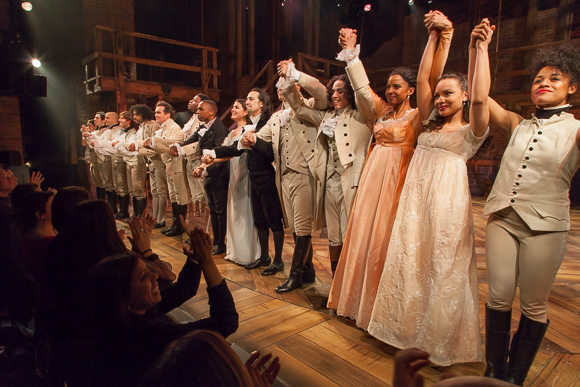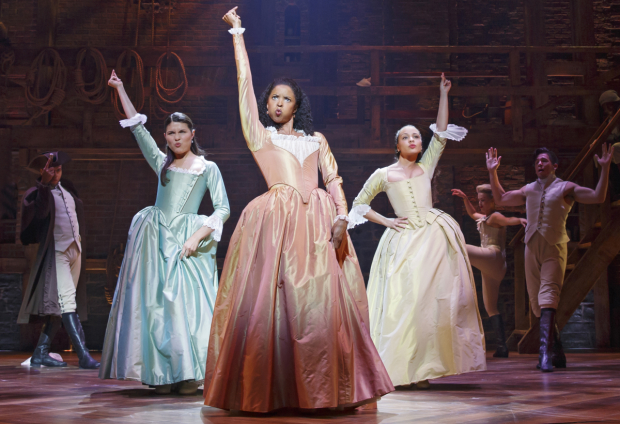Renée Elise Goldsberry's Path From Middle School Class Clown to Hamilton Class Act
Including Michael Jackson obsession, the lead in ”South Pacific”, and ”The Good Wife”.

(© Joan Marcus)
As Hamilton's Angelica Schuyler, Renée Elise Goldsberry plays the sophisticated oldest sibling in the Schuyler-sister trio, a woman so practical and worldly-wise that she passes up a chance at love at first sight in favor of achieving financial stability for her family (by marrying a wealthy suitor). The most seasoned of the three Hamilton actresses in real life too, Goldsberry is the only "sister" with previous Broadway credits to her name, not to mention an IMDB filmography that goes on for days (including her acclaimed performance as Geneva Pine in The Good Wife). Though her real siblings include only brothers, Goldsberry is ideally suited for this big-sister role (onstage and off), possessing a calm presence and fountains of freely dispensed wisdom.
But however centered and gracious Goldsberry is today, it took a lifetime of formative experience to create the person she's become. In fact, as a preadolescent, Goldsberry was something of a class clown. In middle school, she could be found in the back of the class entertaining her fellow students with impressions of their authority figures — that is, until one prescient music teacher recognized that disrespectful mimicry could be something more. "Instead of chastising me for being obnoxious…she said, 'looks like we have a singer in the class'…and decided to sit me in the front and give me all the solos in our songs," Goldsberry remembers. "She could have handled that in a million ways that would have been considered appropriate, and she decided to make me a leader."

(© David Gordon)
"Lay a Strong Enough Foundation"
That moment, according to Goldsberry, became a building block of her identity. Looking back, she's reminded that "there's always at least one person or experience" that sets the trajectory for professionals in the performing arts. When people who loved the arts as kids start crossing professions off their what-I-want-to-be-when-I-grow-up lists, she says, the young adults who keep performing on the list when "other more practical things come in" are the ones who had some early affirmation.
From then on and throughout her teenage years, Goldsberry considered herself a singer but not necessarily a theatrical performer. At the time, her main role models were "anybody that was close to Michael Jackson, probably," Goldsberry recalls, laughing. "I was madly in love with Michael Jackson." So it wasn't until another life-directing event (rife with foreshadowing) that Goldsberry caught the theater bug.
When in her junior year of highschool it was announced that her school would be staging South Pacific, she was encouraged by her friends to go out for the lead role. "The girl who always starred in all the musicals cut her hair to look exactly like Cathy Rigby, and that made everybody in the theater clique really offended, like she just assumed she was gonna get the part," Goldsberry remembers. So at the last minute she and one of her best friends went in to audition — snagging the lead roles of Nellie Forbush and Bloody Mary, respectively. For Goldsberry, it was a seminal moment. Not only did her star turn in South Pacific establish her position as school musical-theater star, it also instilled in her the belief that she could — and would — play any role she felt was right for her. In fact, for years, Goldsberry happily reports, she was totally unaware of how "miscast" she was, as one of the only black girls in a white school, in the role of a woman who "can't accept these Polynesian children because they're brown." She credits the show's director, who cast her in that role "just because he thought I was best for it" with allowing her to see what she connects with in the characters she plays and "not really notice the rest of it."
The lesson has stayed with her to this day. When people who've seen Hamilton comment on the ways she looks different from Angelica, Goldsberry is surprised. "You would have to draw my attention [to the differences]," she says, adding that she thinks unless we teach people to look at skin color as a huge barrier to casting, "they would feel the same way."

(© Seth Walters)
"Time to Take a Shot"
After completing high school and graduating with her BFA from Carnegie Mellon, Goldsberry's career began its steady climb toward stardom. She moved to L.A., where she had success onscreen with projects like One Life to Live and Ally McBeal. Then, in 2002, she landed the part of Nala in Broadway's The Lion King, which, in addition to being her Broadway debut, brought her center stage in a lead role — as she would go on to do as Mimi in Rent and in the 2005 Shakespeare in the Park rock-musical revival of Two Gentlemen of Verona.
"I talk to a lot of friends in the business who have awesome careers and they just want to break into new areas," Goldsberry reflects. "Like, 'I'm working all the time in the ensemble and I want somebody to cast me as a lead.' Or, 'I'm leads in shows but I want somebody to put me in the original production of a show.' Or, 'I'm doing all these shows on Broadway but I really want to get into television. How do I break into this, what do I do?'"
According to Goldsberry, "It just takes that one person." So, "the most important thing you have to do is to show up and believe you can."
Goldsberry knows firsthand that fighting the internal battle to go out for opportunities that seem like long shots can be the hardest part of building a career. In fact, she almost didn't even audition for Hamilton. When she read the character breakdown for Angelica Schuyler, which Lin-Manuel Miranda had written as "Nicki Minaj meets [A Little Night Music's] Desiree Armfeldt", she has a distinct memory of thinking, "I'm never getting that job."
And it's even easier for Goldsberry to convince herself not to audition for new projects now than it was when she was younger, she says, because she has "other jobs" as well as "children and a husband and a million things going on." But all that activity also brings an extra helping of joy. "That's the beauty of my life," sighs Goldsberry. "At night I get to star in a Broadway show and during the day I get to be home and potty train my little two-year-old. I'm so blessed. It's the happiest time of my life."

(© Joan Marcus)
"Satisfied"
Her carpe-diem attitude is just one more reason Goldsberry is perfectly cast as Angelica Schuyler — not to mention pretty much every other role she's ever played, whether it was Rent's Mimi or Angelica. At first glance, it might seem like there's no common thread through all of Goldsberry's characters, but when she looks deeper, Goldsberry finds that these women have a common essence — one that Goldsberry herself shares.
"They're women who look in the face of basically a wall in front of them," she says. "Mimi has this whole song about going out tonight, which is exactly what Angelica Schuyler's first song is, 'look around look around, we live in the greatest city in the world, how lucky we are to be alive right now.' It's the exact same message: right at this particular moment, no day but today, we are lucky to be alive tonight.
The "optimism and excitement and power" in the characters that Goldsberry plays is not only something she identifies with, but it's also what she aspires to. She relates to characters who, like her, "take their life and live it completely with the most passion and possibility." "I can get down with that," she says, "because that's strong."









